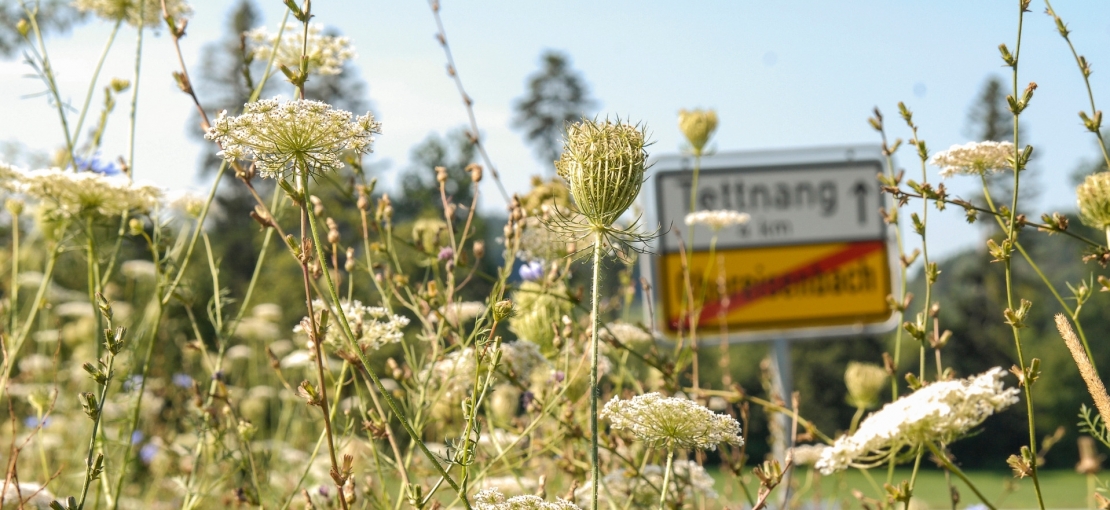
Maintaining diversity of Obereisenbach´s nature
Conserving plants and animals
The VAUDE company headquarters in Tettnang-Obereisenbach are located on the southern outskirts of Obereisenbach, a small town near Lake Constance in southern Germany. To the north of the grounds is a residential area, while to the east, south and west of the facilities are meadows and wooded areas used for agricultural and forestry.
Located on the grounds are product development, management, storage, bag production and maintenance facilities as well as the VAUDE Child Care Center.
34,696 square meters of space for VAUDE
The property measures a total of 34,696 square meters; 56 percent of this area is paved or cultivated. About a quarter of the paved outer surface consists of a special drain stone pavement. This does not seal the surface completely, allowing rainwater to seep through, while also preventing the surface from heating up too much, and allowing small organisms to live in between the cracks.
The VAUDE factory sales and the certified organic VAUDE café, which also serves employees as a cafeteria, are located on the western edge of Obereisenbach. This area measures 3,290 square meters, of which 94 percent is paved.
Geographically, the company premises belong to the Upper Tannauer Valley. In its geological history, a reservoir was formed here during a prolonged ice withdrawal stage in which the area was cut off from moraines in the east, west and north in addition to a glacier in the south.
Characteristic to the area is the abundant fine clay deposits left behind by the former lake, the low slopes of the valley region as well as the hillside springs, especially those emerging at the foot of the moraines. This results in extensive quagmires in the low lying valley regions and hillside spring marshes especially at the foot of the northern and eastern moraines. Large ponds expanded throughout the valley area in the Middle Ages. This valley area is used today almost completely as grassland yet it still features many areas of wetland vegetation.
The highest grades of species and habitat protection are achieved at the foot of forested slopes, where nutrient-poor, calcareous groundwater exits or is near to the surface. Particularly worth mentioning is the Upper Pond area near Obereisenbach (4.1.1, § 24a 8323-435-6566 / forest biotope 8323-0126), in which even Davall's Sedge or Great Fen-Sedge – spread into lime-rich swamps (FFH 7230 II P) and moor grass meadows (§ 24a 8323-435-6567, FFH 6410 II HN). However, here tall forbs and neophytes are spreading out as well.
These grades have not resulted in an increased legal protection status. Although in recent times, (very small sub-areas) have been designated as conservation areas.
However, it must not be forgotten that these areas are only remnants compared to the original numbers. GÖTTLICH (1975) still identified 9 hectares of meadow and 8 hectares of damp grassland, which in the meantime has been reduced to less than 4 hectares. The loss is due to disuse, and near the edge of the Arlen wood, to afforestation as well. Only the continuation of 2 hectares is protected through regular maintenance.
Meadow orchards are typical for and quite widespread in the region and around the ponds. Generally, from the perspective of the habitat network, the conservation, optimization and expansion of these orchards, as well as the maintenance and development of the landscape should be supported.
Excerpt from: Biotope survey 2002, Schmelzer + Friedemann

|
Landscape Plan 2020
The blue and olive surfaces are hay meadows, the yellow dots indicate regional species, the shaded areas are marshes, and the red and green borders are nature conservation areas. |
Compensatory measures for construction sites
In 2013, VAUDE completed an extension of its production workshop and in 2014 converted the former warehouse into office space. In both construction sites, biodiversity conservation issues were considered in the building permit process. Negative impacts on biodiversity were to be completely avoided if possible.
According to the 2002 biotope mapping of the Tannauer Valley, compensatory measures for construction sites are to be primarily carried out in the biodiversity "hot spots" specified therein. This also includes, in VAUDE’s case, the Obereisenbach pond, where a restoration project for hillside springs and hay meadows is used as a compensatory measure for our building operations.

|
Our Location
In Tettnang-Obereisenbach, how we deal with biodiversity is up to us. In respect to our suppliers, we need to do more to raise awareness for this issue. |
“Our” stream
In one of our projects we are renaturing a stream flowing through our premises. You can read more about it at “Projects”.
Four threatened species
According to the biotope mapping of the Upper Tannauer Valley, in the area in which the VAUDE premises are located, four out of 13 threatened Category A species are found here - species that are threatened with extinction nationwide.
- Marsh Fritillary (Euphydryas aurinia)
- Tufted Marbled Skipper (Carcharodus floccifera)
- Scarce Large Blue (Maculinea teleius)
- Geyer’s Whorl Snail (Vertigo geyeri)
These species require near-natural marshes as their habitat. These small areas can still be found today maintained as wetland meadows in the Tettnang-Obereisenbach region.
Species introduced by sea freight
The introduction of invasive species by ocean freight from our production countries poses a potential risk to biodiversity at the Tettnang-Obereisenbach location. As part of the internal project "Green Logistics", which VAUDE will start in 2015, a campaign to raise awareness on this topic among business partners and logistics service suppliers is planned.
In the supply chain, our business activities also have an impact on biodiversity (also see the article "Pioneer in Biodiversity Checks"). For all business activities outside of the Tettnang-Obereisenbach site, there is no data available as yet.
| GRI: | EN11 |
| GRI: | EN12 |
| GRI: | EN14 |
| GRI: | DMA Biodiversity |




